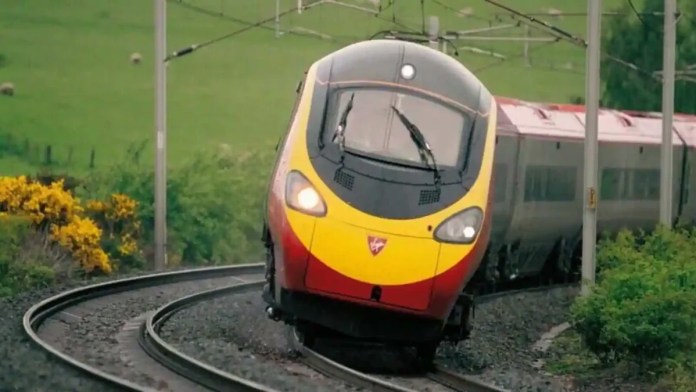Following a few incidents of Vande Bharat trains meeting with minor accidents, the Indian Railways has planned a technological innovation to avert such situations. Locomotives that operate in the United Kingdom, Italy, Portugal, Slovenia, Finland, Russia, the Czech Republic, Switzerland, China, Germany and Romania have inspired the railways.
As a solution, Indian Railways will introduce what is referred to often as ‘tilting trains’ by 2026 with an aim to maintain higher speed on curvy stretches, officials of the department said last evening. They said tilting trains had a mechanism that enabled higher speed on regular broad-gauge tracks, which tilt while undergoing a curve on the track.
Why do a vehicle and its passengers lose balance while on the move on a curved path?
As a train (or another vehicle) takes a curve, objects inside the train experience a centrifugal force (a force in the direction from the centre of the circle towards its circumference, the opposite or the reaction to the centripetal force which is from the circumference towards the centre). This can cause objects and people inside the vehicle to slide about or seated passengers to feel squashed by the outboard armrest, and standing passengers to lose their balance. Tilting trains are designed to counteract this by tilting the carriages towards the inside of the curve, thus compensating for the g-force or causing a balancing force in the opposite direction.
A tilting train may be constructed such that inertial forces cause the tilting (passive tilt), or it may have a computer-controlled powered mechanism (active tilt).
History of tilting trains
The first passive tilting car design was built in the US in 1937, and an improved version was built in 1939. The beginning of World War II ended development. Talgo introduced a version based on their articulated bogie design in the 1950s, and this concept was used on a number of commercial services. Among these was the UAC TurboTrain, which was the first (albeit short-lived) tilting train to enter commercial service in 1968 in the US and Canada.
Parallel experiments in Japan and Italy through the 591 Series[1] and the Fiat Y 0160 developed into the highly successful 381 series which began services in 1973 and is in service today, and the Pendolino family currently being used in 11 countries since 1976. All of these had problems with short curves like those in switchyards, where they tended to sway about. Also, because of the way the carriages always swung outward, they placed more weight on the outside of the curve, which limited their improvement in cornering speed to about 20%.
Starting in the late 1960s, British Rail began experiments with its Advanced Passenger Train (APT) which pioneered the active-tilt concept. This used hydraulic rams on the bottoms of the carriages to tilt them, rotating them around their centre point rather than swinging outward. This had the advantage of keeping the carriage centred over the bogies, which reduced load on the rails and could be turned off when navigating switches. Due to lengthy delays, the APT did not begin test runs until 1981 and entered commercial service only briefly in 1985. By this time, the Canadian LRC design had become the first active tilting train to enter full commercial service, starting with Via Rail in 1981.
Fiat developed their Pendolino design into the most successful type of tilting train, with over 500 trains active in Europe. The concept of active tilt as a whole has been independently developed by many companies. Active tilting systems are widely used today.
Where will Indian Railways apply this innovation? When will the new trains begin to ply?
Officials said that 100 new units of the semi-high speed Vande Bharat trains now in the manufacturing stage will use this technology. “About 100 Vande Bharat trains will be equipped with this technology by 2024. We will tie up with a technology partner and get this over the next two to three years,” a railways official said.
These trains with sleeper coaches will begin to ply by the first quarter of 2024.
What are broad-gauge tracks?
In its history, the Indian Railways has seen three types of tracks, classified based on their width or, in other words, the distance between a set of parallel rails.
A broad-gauge (distance between the rails) railway track is broader than the standard 1,435 mm used by the railways. Internationally, a broad-gauge track has parallel rails separated by 1.676 m.
In narrow-gauge tracks, the parallel rails are separated by 0.762 m whereas the distance is 1 m in the case of meter-gauge tracks. These narrower tracks have been installed in hilly regions where most trains that ply in the plains do not reach. Obviously, the trains that run on these tracks have narrower widths between the wheels on either side to fit on the narrower tracks.
Is this only for domestic use?
No, Indian Railways is preparing to become a major exporter of Vande Bharat trains by 2026, primarily to markets in countries in Europe, South America and East Asia, a second official said.
The source said that Indian Railways was aiming to start working on the export once the next lot of 75 VB trains (expected to be operational by August next year) clock at least 10 lakh km in the coming years. “The railways is also constructing a 59-km testing track between Gudha-Thathana Mithri in Jodhpur Division (near Jaipur) to carry out test runs with a maximum speed of 220 km/h. This track is expected to get completed by January 2024 and will be used to conduct trail runs of trains that will be exported,” the official said.




You must log in to post a comment.